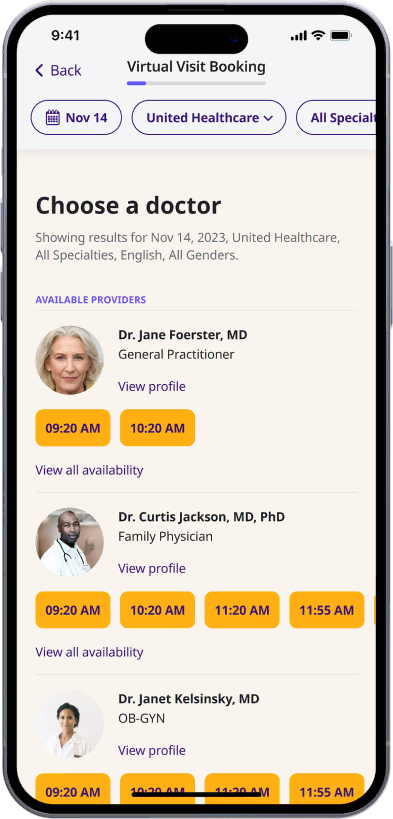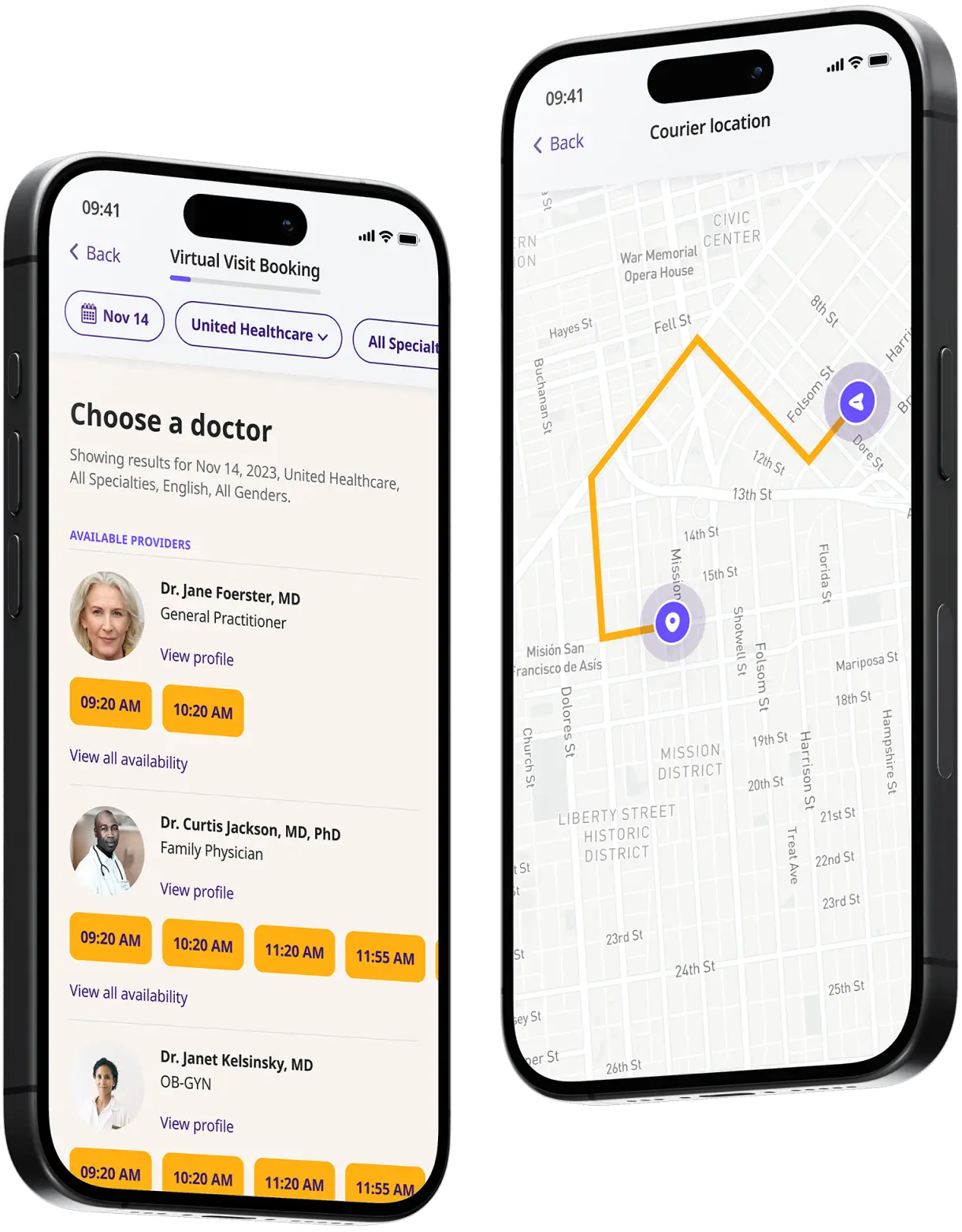Fever Treatment Online
Find fast relief from fever—consult an online doctor for expert care and tailored treatment.


Available in 50 states. Insurance accepted.
Fast
virtual visits
24/7 care
assistants
Prescriptions
as needed

24/7 Personal Care
Consult with a physician in 15 minutes, refill an Rx or chat with our care assistants.

Affordable & Convenient
See your cost upfront and get treatment for hundreds of different conditions.

Insurance Accepted
We accept most major insurance plans, making healthcare easy and affordable.
See If Delivery Is Available Near You
Delivery Not Available
Enter your ZIP code to check if prescription delivery is available in your area and how soon your meds could arrive.
How to get started
Choose your doctor, start a virtual visit, and have your prescriptions sent to your preferred pharmacy for pickup — all in just a few easy steps.
Choose a doctor
Choose a physician by availability, specialty, ratings, and more.

Start your video visit
Connect with a doctor in minutes on a secure video call.

Get your prescription
Pick up your meds or have them delivered in as little as an hour.

Available in 50 states. Insurance accepted.
One-Time
Physician Visit
One-time visit with a physician for diagnosis, treatment, Rx, labs, referrals, and doctor’s notes.
Accepted Insurances
See why people turn to DrHouse...
As seen in

Fever Treatment Online
What causes a fever?
A fever arises as a part of your body’s defense against infection. The increase in body temperature is triggered by substances known as pyrogens, which can either be produced by your immune system or by external pathogens such as bacteria or viruses.
When these pyrogens bind to certain receptors in the brain’s hypothalamus, your body’s temperature set point rises, leading to an increase in body heat. T
his elevated temperature helps your body fight off the infection by impairing the growth of bacteria and viruses, enhancing immune cell function, and speeding up chemical reactions that aid in healing.
Fever symptoms
Fever symptoms can vary widely depending on what is causing the fever. The most obvious symptom of a fever is an increase in body temperature, typically above the normal range of 98.6°F (37°C).
However, several other symptoms often accompany this increase in temperature, making it easier to recognize when you might have a fever. Common symptoms include:
- Chills and shivering: As your body adjusts to a higher set point for temperature, you may feel cold despite having a high body temperature. This can lead to shivering as your body tries to generate more heat.
- Sweating: Sweating is another way your body tries to regulate temperature; as your body temperature peaks and begins to decrease, sweating can occur.
- Headache: The discomfort from a fever often includes a headache, which can vary from mild to severe.
- Muscle aches and general weakness: Fever can trigger muscle aches, known as myalgias, and a feeling of weakness or lethargy.
- Dehydration: Fever increases your body’s metabolism and temperature, which can lead to fluid loss and dehydration.
- Loss of appetite: Many people experience a decrease in appetite when they have a fever.
- Irritability and mood changes: Particularly in children, a fever can lead to irritability or mood changes.
These symptoms can be indicators of a feverish condition and suggest that your body is fighting off an infection or other illness.
How is a fever treated?
Treating a fever effectively often depends on its severity and underlying cause. For many mild cases, treatment focuses on making the individual more comfortable, as the fever itself is a natural and beneficial response to infection.
Here are common approaches to managing a fever:
- Rest: Encouraging the body to rest is crucial as it helps conserve energy needed to fight off the infection causing the fever.
- Hydration: Drinking plenty of fluids is essential to counteract the dehydration that can occur with fever. Water, juices, and broth can help stay hydrated.
- Medication: Over-the-counter antipyretics (fever reducers) such as acetaminophen or ibuprofen can be used to relieve discomfort and lower body temperature. These medications should be used according to package instructions or a doctor’s advice.
- Cooling measures: Applying a cool cloth to the forehead, taking a lukewarm bath, or using a fan can help reduce body temperature. However, extreme cold such as ice baths should be avoided as they can cause shivering, which may raise body temperature.
- Light cothing: Dressing in light clothing and keeping the room temperature cool can help the body regulate its temperature more effectively.
For more severe fevers or those accompanied by worrying symptoms such as a rash, difficulty breathing, or persistent vomiting, it is important to seek medical advice promptly.
When to see a doctor about a fever?
Here are guidelines on when to see a doctor about a fever:
- High temperature: Adults should consult a doctor if the fever reaches 103°F (39.4°C) or higher, or if any fever persists for more than three days.
- Infants and toddlers: For infants under 3 months, a doctor should be consulted if there is any fever (temperature above 100.4°F or 38°C). For children between 3 months and 3 years, see a doctor if they have a fever above 102.2°F (39°C) or if the fever persists beyond 24 hours.
- Associated symptoms: Seek medical advice if the fever is accompanied by symptoms such as a severe headache, stiff neck, shortness of breath, significant vomiting, abdominal pain, unusual skin rash, or if the person seems unusually sleepy or irritable.
- Immunocompromised individuals: People who have weakened immune systems due to conditions like HIV, cancer treatments, or other medical conditions should consult a healthcare provider when they have a fever.
- No improvement with medication: If the fever does not decrease after taking over-the-counter medications like acetaminophen or ibuprofen, it is advisable to see a doctor.
- Dehydration signs: If symptoms of dehydration appear, such as a dry mouth, severe thirst, dry skin, little urination, or severe weakness, medical attention is needed.
How can DrHouse help?
DrHouse offers a comprehensive telehealth service that operates 24/7, allowing patients to access medical care anytime, from anywhere.
Through the DrHouse app, users can connect with licensed online doctors who provide medical consultations for a wide range of health concerns, including fever management.
This convenient platform ensures that patients receive timely advice and treatment recommendations without the need for in-person visits, making it easier to address health issues at their convenience.
Here are some key benefits of using DrHouse:
- Quick and convenient access to medical professionals: With DrHouse, there’s no need to wait in long queues or schedule appointments. Users can simply log into the app and connect with a doctor within minutes.
- Personalized care: Our team of doctors takes the time to understand each patient’s unique symptoms and medical history before recommending a personalized treatment plan.
- Cost-effective: Online consultations are generally more affordable than in-person visits, making it a cost-effective option for fever treatment.
- Available in all 50 states: DrHouse is available to users across the United States, making it accessible to anyone in need of medical care.
- Secure and confidential: Your health information is kept strictly confidential on our secure platform, ensuring privacy and peace of mind for patients.
- Prescriptions and follow-up care: If necessary, our doctors can provide prescriptions and follow-up care through the app, ensuring seamless treatment from start to finish.
Don’t let a fever disrupt your life and daily activities. With DrHouse’s telehealth service, you can receive prompt and effective treatment without leaving the comfort of your own home. Download the app today and take control of your health.
Frequently asked questions




